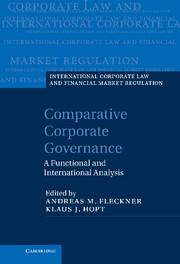1 - Comparative corporate governance: the state of the art and international regulation
from Part I - General report
Published online by Cambridge University Press: 05 July 2013
Summary
Abstract
Corporate governance, i.e. the system by which companies are directed and controlled, has become a key topic for legislators, practitioners, and academics in all modern industrial states. The recent financial crisis has highlighted the problems. Yet one goes astray if one does not understand how the unique combination of economic, legal, and social determinants of corporate governance functions in each country. This functional comparative analysis based on reports from thirty-three countries and with references to economic literature deals with the concepts, instruments (including soft law), and sources of corporate governance, and analyzes the regulation and practice of the various actors in corporate governance: mainly the board and the shareholders, but also labor, gatekeepers (in particular the auditors), the supervisors, and the courts. In the end, a great deal of convergence emerges, though many path-dependent differences remain.
Introduction
Corporate governance is a greatly discussed topic, particularly in the aftermath of the recent financial crisis. In less than one year, it has led to three Green Papers by the European Commission; and in individual European countries and elsewhere in the world, it has attracted increased attention from legislators, courts, corporate governance commissions, members of academia, and the general public alike. Corporate governance as a concept and as a problem area was first discussed in the US; later, the European debate started in the UK. From there the issue of corporate governance began its pervasive course through all the modern industrial states, including Australia, China, and Japan. Contributions and research projects on the topic abound all over the world.
- Type
- Chapter
- Information
- Comparative Corporate GovernanceA Functional and International Analysis, pp. 3 - 102Publisher: Cambridge University PressPrint publication year: 2013
References
- 7
- Cited by



